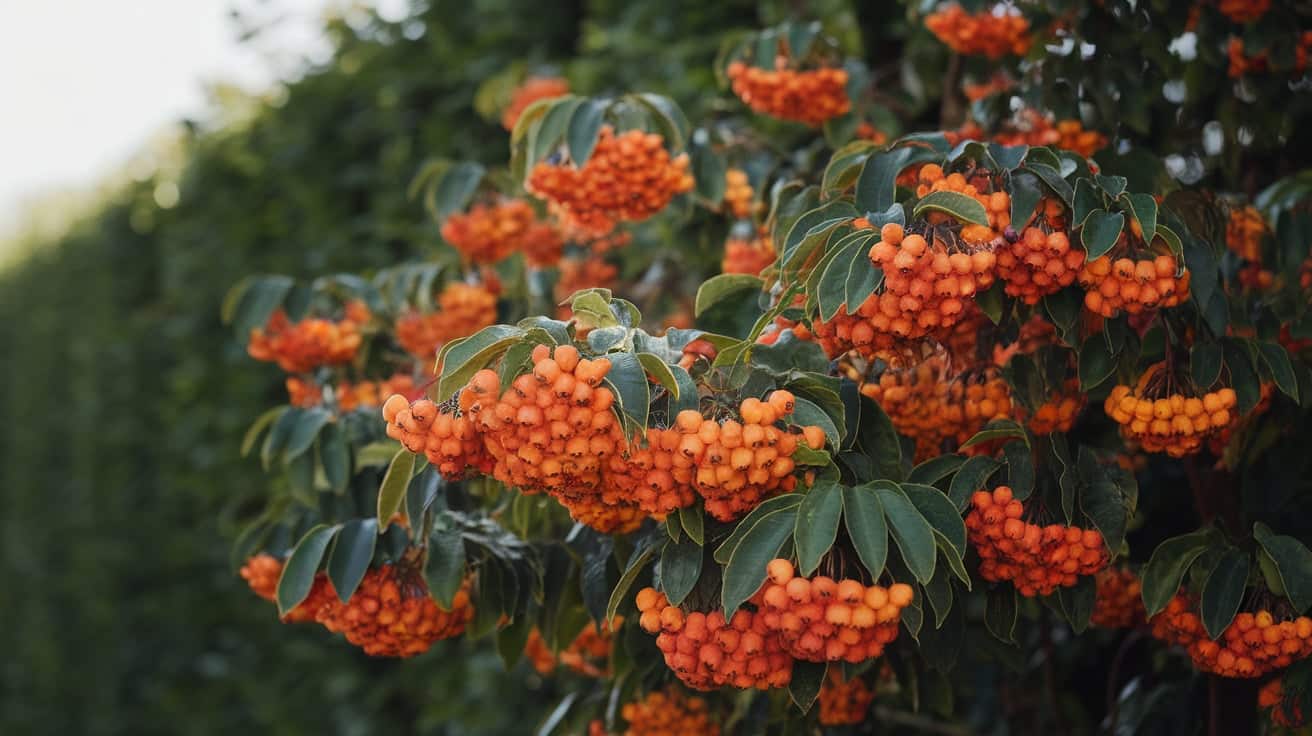Your pyracantha shrub could be the star of your garden with its bright berries and thick growth, but right now it’s probably just a thorny mess that catches everyone who walks by.
Here’s what most homeowners don’t realize: the difference between a beautiful, well-behaved pyracantha and an overgrown nightmare comes down to knowing exactly when and how to prune it.
I’ve been helping gardeners change their unruly pyracantha bushes for years, and I can tell you that proper pruning timing makes all the difference.
When you get it right, you’ll have a profusion of colorful berries, controlled growth, and a plant that actually adds beauty to your yard, rather than frustration.
In this guide, I’ll cover the best pruning timing, step-by-step techniques, ideal growing conditions, and solutions to common pyracantha problems that keep your shrub healthy and beautiful year-round.
What is Prune Pyracantha?
Prune Pyracantha refers to the horticultural practice of trimming and maintaining Pyracantha shrubs, commonly known as firethorn. Pyracantha is a genus of thorny, evergreen shrubs belonging to the rose family (Rosaceae), native to regions of Asia, Europe, and parts of Africa.
These ornamental plants are highly valued in landscaping for their dense growth habit, clusters of small white spring flowers, and brilliant displays of orange, red, or yellow berries that persist through winter.
The shrubs are characterized by their sharp, needle-like thorns that make them excellent choices for security hedging and barrier plantings.
Key Characteristics and Considerations About Pyracantha
- Seasonal timing requirements: Pyracantha should be pruned immediately after the flowering period ends, typically in late spring to early summer, to preserve the developing berry buds for the following season.
- Physical characteristics and growth habit: These robust shrubs can reach heights of 6-18 feet with equal spread, featuring dense branching patterns and formidable thorns that can be up to 2 inches long.
When to Hard Prune Pyracantha for Perfect Garden Results?
Prune pyracantha in late winter to early spring for optimal growth; avoid pruning during flowering or berry seasons to prevent damage, reduced berries, and disease. For wall-trained pyracantha, keep shaping minimal after flowering and reserve heavier work for late winter; a light tidy in late summer is fine for wayward shoots.
| Timing | When | What to Do | Why |
|---|---|---|---|
| Late Winter to Early Spring | February to March (before new growth) | Prune to shape and cut | The plant is dormant, has a low disease risk, easy to see the structure |
| Summer Pruning | June to July | Light pruning (no more than 20% removal) | The plant is actively growing, so avoid heavy cutting |
| Flowering Season | April to June | Do not prune | Flowers are energy stores; pruning reduces berries |
| Berry Season | September to November (or into winter) | Do not prune | Berries need time to ripen; pruning harms berry display |
How to Prune Pyracantha Like a Pro?
Pruning pyracantha like a pro means using the right tools and a thoughtful, step-by-step approach to remove damage, improve airflow, and shape your shrub for both beauty and health.
Tools You Need for Safe Pruning
- Heavy-Duty Gloves
- Sharp Loppers
- Clean Pruning Shears
Step 1: Remove All Dead and Diseased Wood

Start by cutting out any dead, broken, or diseased branches first. Dead wood looks brown or black and breaks easily when bent. Diseased wood often shows dark spots, cankers, or unusual growths.
Cut these branches back to healthy wood where you see white or green inside. This prevents problems from spreading to healthy parts of your plant.
Step 2: Thin Out Overcrowded Branches
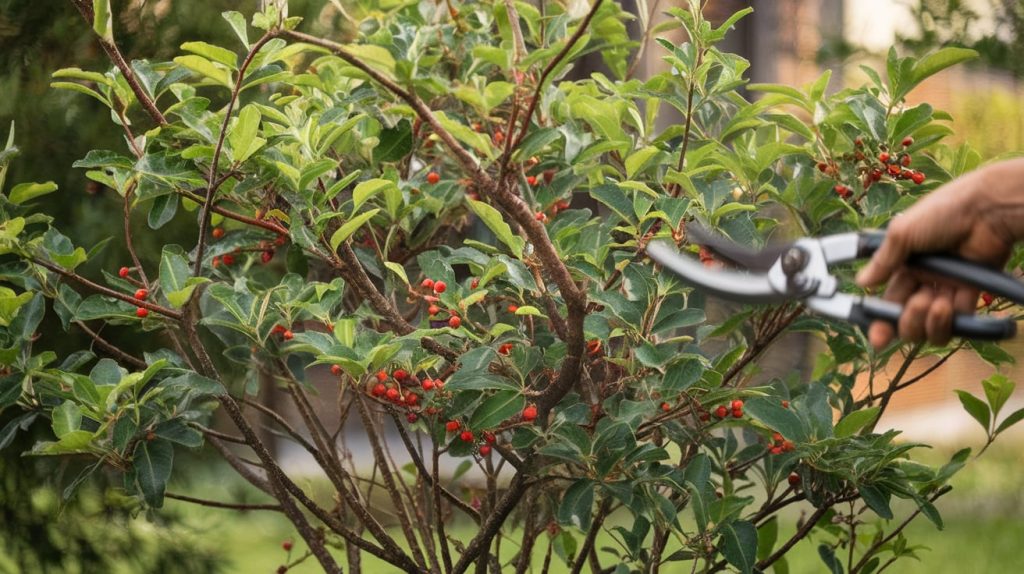
Look for areas where branches cross or rub against each other. Remove the weaker branch to prevent damage and improve air circulation.
Cut branches that grow toward the center of the plant since they block light and air from reaching the inner areas. Good airflow prevents fungal diseases and helps berries ripen properly throughout the plant.
Step 3: Shape for Beauty and Health
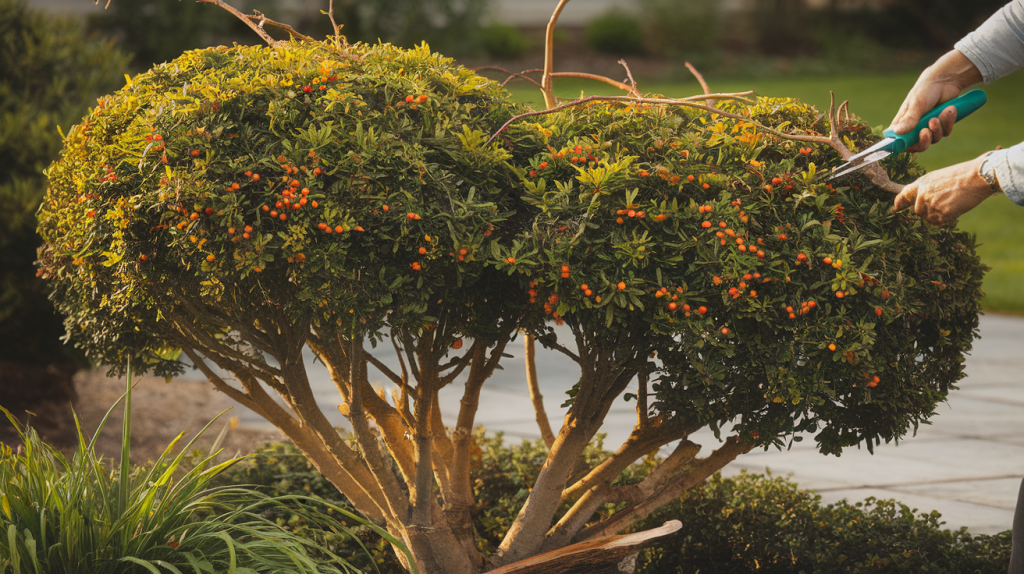
Cut back long branches that stick out beyond your desired shape. Make cuts just above an outward-facing bud to encourage growth in the right direction.
Remove low branches that drag on the ground or block walkways. Step back frequently to check your progress and maintain a balanced, natural-looking shape that fits your space.
Where to Grow Pyracantha for Maximum Impact?
Pyracantha thrives in full sun to partial shade with well-drained, moderately fertile soil. Ideal for fences and property boundaries, or as a hedge, it offers privacy, security, and bird-friendly berries while requiring minimal care.
1. Light Requirements: Full Sun to Partial Shade
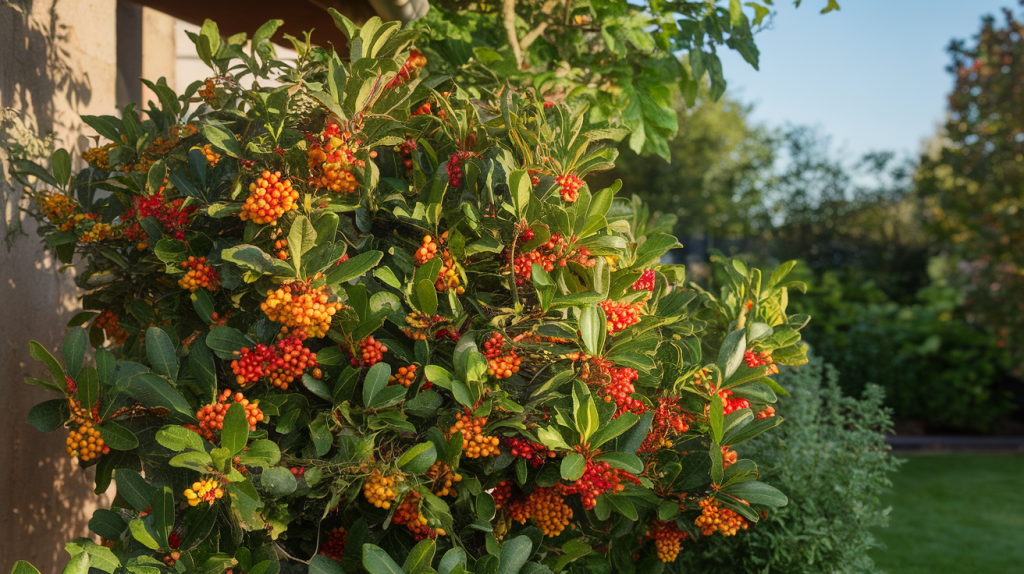
- Pyracantha loves sunlight but isn’t picky about getting it all day long. Full sun gives you the most flowers and berries. Your plant will be thick with colorful berries that last well into winter.
- Morning sun is more important than afternoon sun. Your plant needs at least 4-6 hours of direct sunlight daily for good berry production. Too much shade means fewer flowers and sparse berries.
- In very hot areas, some afternoon shade can actually be beneficial. It prevents the leaves from scorching and reduces water stress. Your pyracantha will thank you for protection from brutal afternoon heat above 90°F.
Pro Tip: Plant on the east or south side of your property for morning sun and natural afternoon shade from nearby structures.
2. Soil Needs: Well-Drained and Moderately Fertile
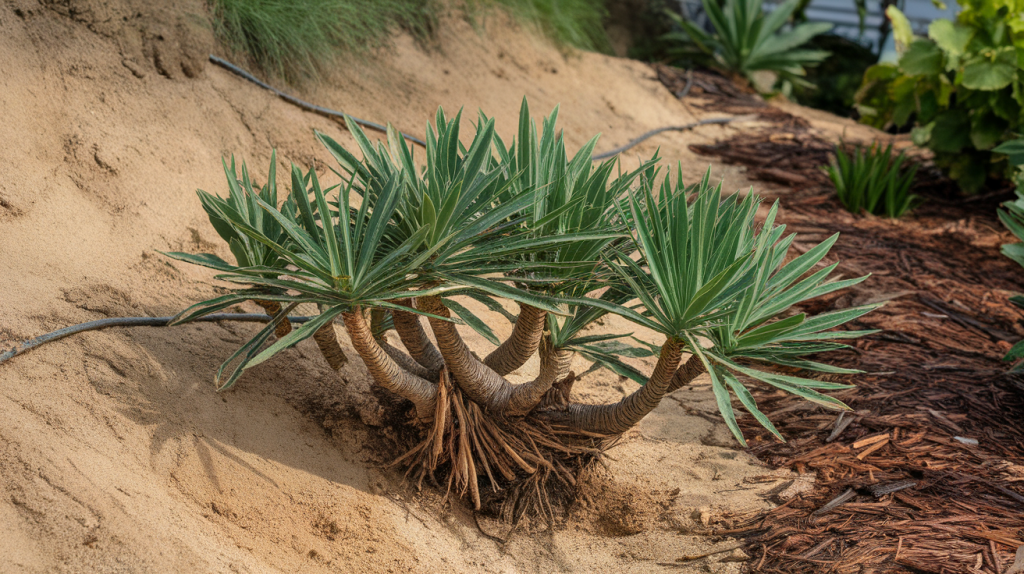
- Pyracantha isn’t fussy about soil but hates wet feet. Well-drained soil is non-negotiable. Standing water kills the roots and invites disease problems. Your plant can handle clay, sand, or loam as long as water doesn’t pool around the base.
- Moderately fertile soil works best. Rich soil makes the plant grow too fast with weak, floppy branches. Poor soil slows growth and reduces berry production.
- Test your drainage by digging a hole and filling it with water. If water sits there for more than a few hours, you need to improve drainage. Add coarse sand or plant on a slight slope to help water move away from the roots.
Pro Tip: Mix in some compost when planting, but skip the heavy fertilizers that make pyracantha grow too fast and weak.
3. Perfect Locations: Boundaries and Barriers
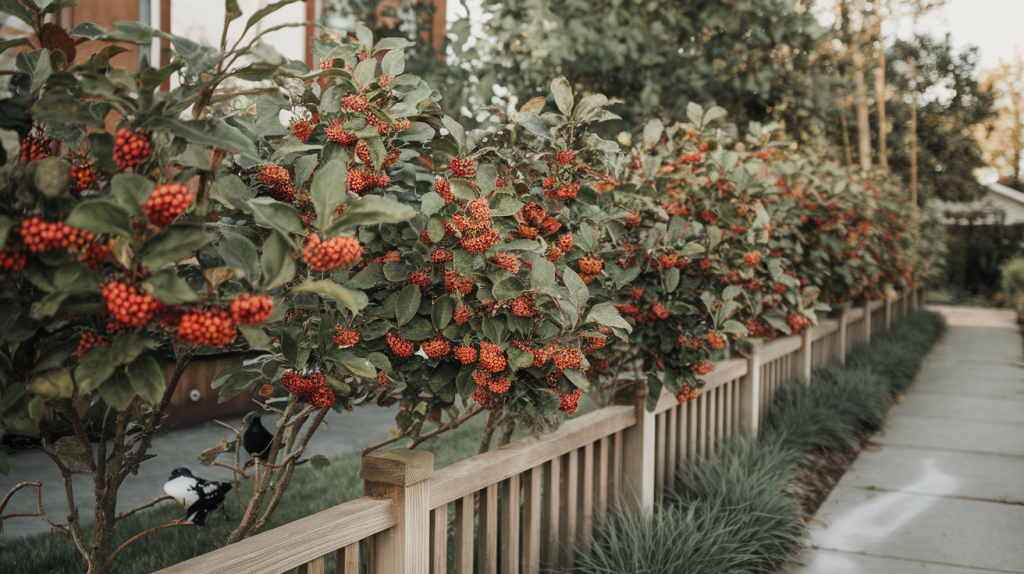
- Pyracantha works great along property lines where you want privacy and security. The thorns keep unwanted visitors out while the berries attract birds you do want. Plant it where people won’t accidentally brush against the thorns.
- Fence lines are ideal spots because the structure gives your plant support as it grows. The thorns add extra security to your fence line. Just make sure you can reach the plant for pruning without getting trapped between thorns and the fence.
- Corner areas work well too. These spots are often overlooked in landscaping, but pyracantha fills them in nicely. The plant can spread out without interfering with foot traffic or obstructing important views.
Pro Tip: Plant at least 3 feet away from sidewalks and patios so the thorns won’t catch people walking by.
Common Pyracantha Problems & Fixes
Common pyracantha problems include scab, fireblight, overgrowth, few berries, and root rot. Address these issues with timely pruning, proper care, improved drainage, and the selection of resistant varieties for healthier plants.
Problem 1: Pyracantha Scab (Black Spots)
What You’ll See: Black spots on leaves and berries. Leaves drop off, and berries shrivel up, looking ugly.
The Fix: Cut out infected branches immediately. Clean up all fallen leaves and berries from the ground. The fungus lives in this debris over winter. Choose scab-resistant varieties when replanting. Thinning overcrowded branches improves air circulation.
Problem 2: Fireblight Disease
What You’ll See: Branches look scorched with brown, wilted leaves. Shoots die back and may ooze sticky liquid.
The Fix: Prune infected branches immediately, cutting at least 12 inches past any damage. Disinfect tools between cuts with rubbing alcohol. Remove all infected material from your yard. This spreads fast, so act quickly when you spot it.
Problem 3: Plant Growing Out of Control
What You’ll See: Pyracantha taking over your yard, growing into walkways, or getting too tall and wide.
The Fix: Prune twice a year, with heavy pruning in late winter and light touch-ups in summer. Remove up to one-third of old growth each year. If space is limited, consider replacing with dwarf varieties. Regular maintenance prevents overgrowth problems.
Problem 4: Few Or No Berries
What You’ll See: Plenty of green growth but sparse berries or none at all.
The Fix: Ensure your plant receives at least 6 hours of sunlight daily. Avoid over-fertilizing with excessive nitrogen, as it can lead to excessive leaf growth rather than fruit production. Don’t prune during the flowering season. The plant needs 2-year-old wood for berry production, so leave some older branches.
Problem 5: Root Rot From Wet Soil
What You’ll See: Yellow leaves, wilting even when the soil is moist, or the plant dying from the bottom up.
The Fix: Improve drainage immediately by adding coarse sand or gravel to the soil. Move container plants to better-draining pots. Reduce watering frequency. In severe cases, relocate the plant to higher, drier ground.
Conclusion
Mastering how to prune pyracantha comes down to two simple things: timing your cuts right and using the proper technique. When you get both of these right, you’ll have a shrub that produces loads of berries, stays the perfect size, and actually adds beauty to your garden instead of becoming a thorny problem.
Your pyracantha doesn’t have to be that plant everyone complains about. With late winter pruning, summer touch-ups when needed, and the right tools, you can change it into a garden feature that receives compliments instead of complaints.
The difference between a well-pruned pyracantha and an overgrown mess is just a matter of knowing when to act.
Ready to take control of your pyracantha? Mark your calendar for late February or early March and plan your first proper pruning session.
Share your pruning success stories in the comments below. We’d love to hear how your pyracantha changed! Your future self will thank you when you’re enjoying those beautiful berries instead of battling thorny chaos.
